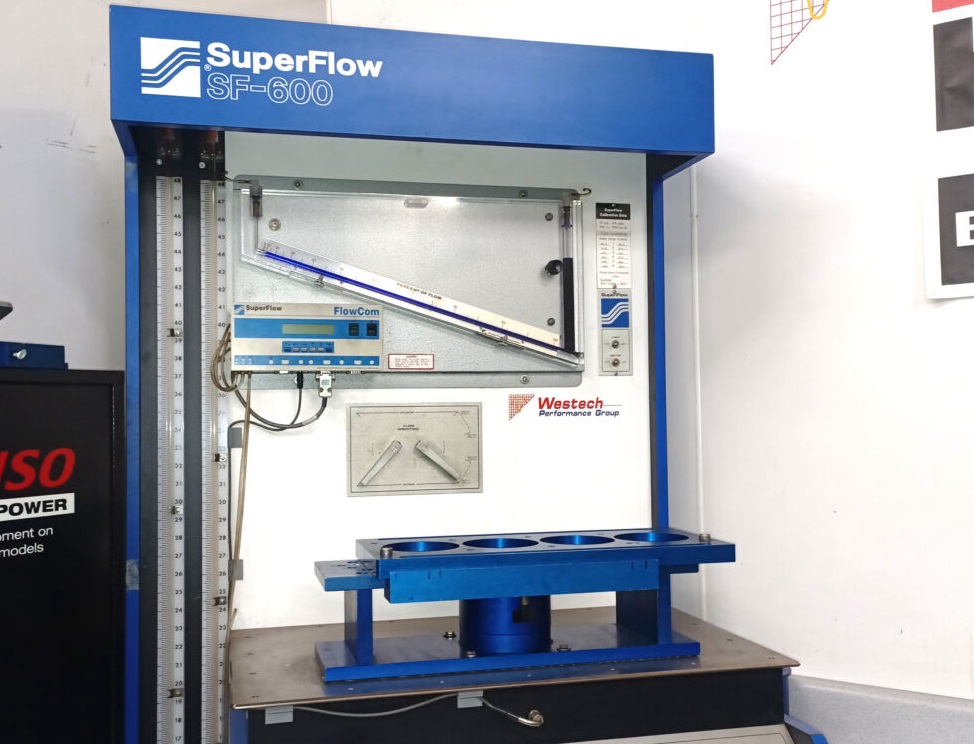Flowbench Testing—Measuring Engine Airflow and Making Needed Corrections

The term cfm (cubic feet per minute) generates much confusion about airflow. This is a result of the fact that air is compressible, and the volume flow in one place differs from the flow at another place.
Air flows through the test orifice and then through the flow orifice. Obviously, the same airstream flows through both orifices, but because the flow orifice sees air at a lower pressure (and air expands with lower pressure), a larger volume of air (cfm) is flowing through the flow orifice than the test orifice. This causes confusion when we are talking about the cfm of air flowing through the bench. To make sense of the cfm number, you must also ask, “Where is that flow being measured?”
SCFM (Standard Cubic Feet per Minute)
The easiest way to avoid confusion is to always quote flow rates in lbs./hr., or mass terms. At least in mass flow rates, the stream of air has the same flow rate everywhere in the system. But air is commonly referred to in terms of cfm, so we must live with it. To get around the problems caused by the compressibility of air, a new concept (scfm) was invented to standardize flow back to standard conditions. Scfm is a mass flow number expressed as cfm.
Standard cubic feet per minute, or scfm, answers the question, “If I took the amount of air I have flowing here and set its temperature and pressure to standard (sea-level) conditions, how much cfm would I see?” This is a roundabout way of expressing the mass of airflow in a term that contains the familiar letters cfm.
Bench Flow
SuperFlow benches all read out flow in bench cfm which is neither the actual volume of air flowing through the bench, nor is it the scfm flowing through the bench. A flowbench does not actually measure flow, but simply compares the flow characteristics of the unit under test to a reference orifice inside the bench. Because of this, the bench cfm number reported is the amount of air the test piece would flow at standard conditions.
For example, a flowbench can be set up at a 6000-ft. altitude with a particular head and measure, for instance, 250 cfm of flow at a test pressure of 25 inches of water. Then you could move the bench and test piece to sea level and measure the same 250 cfm of flow.
When the bench reports 250 cfm of flow, it is a measure of how well the test piece flows air, but is not a measurement of real airflow in the bench.
Actual Flow
Until recently, bench flow was the only answer of interest to flowbench users. In the traditional application of using the flowbench to improve the airflow characteristics of engine parts, the flowbench flow number is the best assessment of the test piece’s ability to allow airflow.
With the recent application of flowbenches to industrial applications, flowbench users now need to know the actual rate of airflow through the test piece. For example, a life test of an air filter involves drawing a specific volume of dirty air through an air filter. This means the bench must report the actual flow—not the comparative bench flow traditionally reported. Even worse, these users want to command actual flow rate and have the bench servo the actual flow (cfm) to the specified value. This brings up a number of issues about how a flowbench actually works.
The actual cfm (acfm) is the actual volume flow rate through the test piece. Since the bench cfm does not change with altitude, a formula is available to correct bench cfm to acfm. In the graph below, you can see that bench cfm, acfm, and scfm are all the same value at standard sea-level conditions.
As altitude increases (density decreases), the flowbench continues to read the same flow rate. In reality, a larger actual volume of air is going through the bench (a larger acfm), but the density of the air is lower such that less mass flow (lower scfm) is going into the flowbench.
Measured flow vs. altitude
Of course, temperature and barometric pressure changes also affect air density and are included in the correction formulas.
